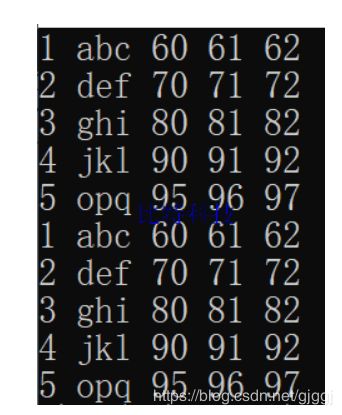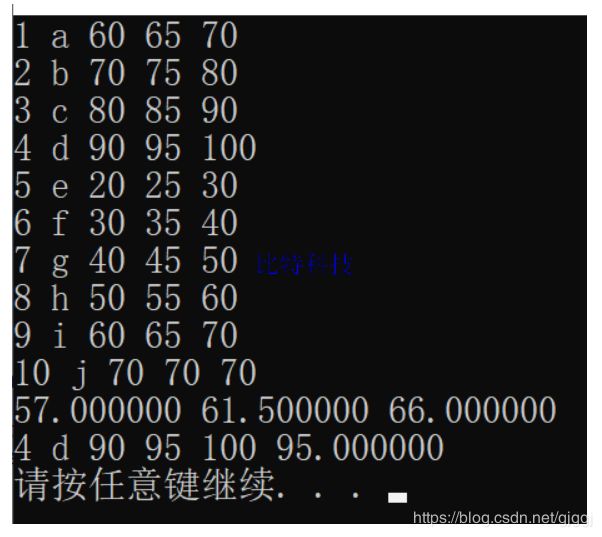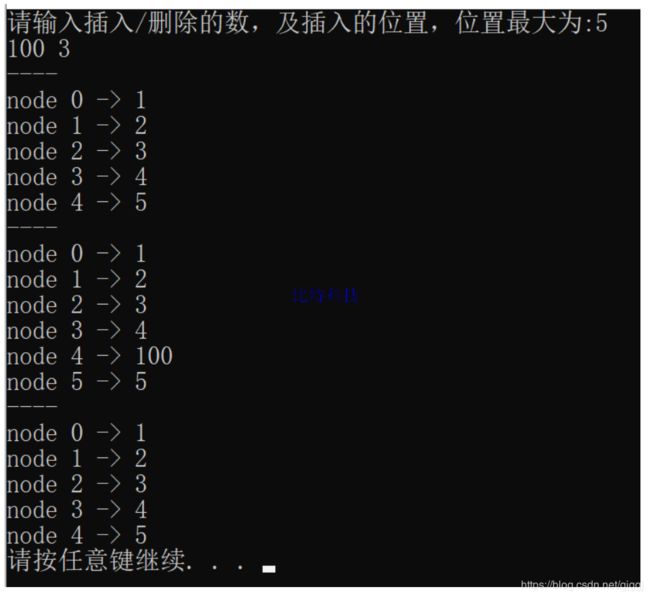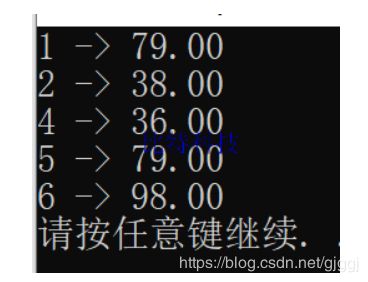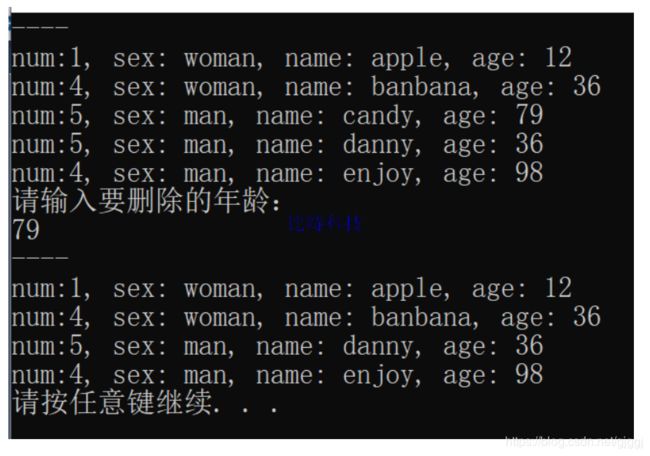C语言程序设计第五版谭浩强课后答案 第九章习题答案
C语言程序设计第五版谭浩强第九章答案
- 1.定义一个结构体变量(包括年、月、日)。计算该日在本年中是第几天,注意闰年问题。
- 2.写一个函数days,实现第1 题的计算。由主函数将年、月、日传递给days函数,计算后将日子数传回主函数输出。
- 3.编写一个函数print,打印一个学生的成绩数组,该数组中有5个学生的数据记录,每个记录包括num,name,score[3],用主函数输人这些记录,用print函数输出这些记录。
- 4.在第3题的基础上,编写一个函数input,用来输人5个学生的数据记录。
- 5.有10个学生,每个学生的数据包括学号、姓名、3门课程的成绩,从键盘输人10个学生数据,要求输出3门课程总平均成绩,以及最高分的学生的数据(包括学号、姓名、3门课程成绩、平均分数)。
- 6.13个人围成一圈,从第1个人开始顺序报号1,2,3。凡报到3者退出圈子。找出最后留在圈子中的人原来的序号。要求用链表实现。
- 7.在第9章例9.9和例9.10的基础上,写一个函数del,用来删除动态链表中指定的节点
- 8.写一个函数insert,用来向一个动态链表插入结点
- 9.综合本章例9.9(建立链表的函数creat)、例9.10(输出链表的函数print)和本章习题第7题(删除链表中结点的函数del)、第8题(插入结点的函数insert),再编写一个主函数,先后调用这些函数。用以上5个函数组成一个程序,实现链表的建立、输出、删除和插入,在主函数中指定需要删除和插人的结点的数据。
- 10.已有a,b两个链表,每个链表中的结点包括学号、成绩。要求把两个链表合并, 按学号升序排列。
- 11.有两个链表a和b,设结点中包含学号、姓名。从a链表中删去与b链表中有相同学号的那些结点。
- 12.建立一个链表,每个结点包括:学号、姓名、性别、年龄。输入一个年龄,如果链表中的结点所包含的年龄等于此年龄,则将此结点删去。
- C语言程序设计第五版谭浩强更多答案

1.定义一个结构体变量(包括年、月、日)。计算该日在本年中是第几天,注意闰年问题。
解题思路及答案:
- 用一个日期数组保存每一月的天数,二月的天数记为28天,后面根据输入的时间确定是否是闰年的二月,如果是,天数在加1。
#include 运行截图:
2.写一个函数days,实现第1 题的计算。由主函数将年、月、日传递给days函数,计算后将日子数传回主函数输出。
#include 运行截图:
3.编写一个函数print,打印一个学生的成绩数组,该数组中有5个学生的数据记录,每个记录包括num,name,score[3],用主函数输人这些记录,用print函数输出这些记录。
#include 运行截图
4.在第3题的基础上,编写一个函数input,用来输人5个学生的数据记录。
#include 运行截图:
5.有10个学生,每个学生的数据包括学号、姓名、3门课程的成绩,从键盘输人10个学生数据,要求输出3门课程总平均成绩,以及最高分的学生的数据(包括学号、姓名、3门课程成绩、平均分数)。
#include 运行截图:
6.13个人围成一圈,从第1个人开始顺序报号1,2,3。凡报到3者退出圈子。找出最后留在圈子中的人原来的序号。要求用链表实现。
解题思路及答案:
创建一个环形链表,给链表中的每一个节点从1~13编号,然后开始淘汰过程,对于淘汰的节点,序号置为0,淘汰完成之后,找到序号不为0的即为最后留下的。
#include 运行截图:
7.在第9章例9.9和例9.10的基础上,写一个函数del,用来删除动态链表中指定的节点
解题思路及答案:
首先创建一个带头的单链表,然后让用户输入需要删除的节点,调用del函数,找到需要删除的节点,把待删除节点的前驱和后继重新链接。
#include
#include
typedef struct LNode
{
int num;
struct LNode *next;
} LNode;
//创建含有n个值的节点
LNode* creat(int n)
{
LNode *head, *p;
head = (LNode *)malloc(sizeof(LNode));
p = head; //头节点为0 加上头节点共n + 1个节点
head->num = 0;
head->next = NULL;
for (int i = 1; i <= n; i++)
{
LNode *newNode = (LNode *)malloc(sizeof(LNode));
newNode->num = i;
newNode->next = NULL;
p->next = newNode;
p = p->next;
}
return head;
}
//删除值为n的节点
void del(int n, LNode *head)
{
LNode *pre, *current;
pre = head;
current = head->next;
//从第一个有效节点开始查找待删除节点
printf("delete node %d\n", n);
while (current != NULL)
{
//找到待删除节点,重新链接,释放待删除节点
if (current->num == n)
{
pre->next = current->next;
free(current);
break;
}
//更新查找位置
pre = current;
current = current->next;
}
}
int main()
{
LNode *head, *p;
int n;
head = creat(10);
printf("请输入需要删除的节点:1-10\n");
scanf("%d", &n);
del(n, head);
int i = 1;
p = head->next;
while (p != NULL)
{
printf("p %d.num -> %d\n", i, p->num);
p = p->next;
i++;
}
return 0;
}
运行截图:
8.写一个函数insert,用来向一个动态链表插入结点
#include 运行截图:
9.综合本章例9.9(建立链表的函数creat)、例9.10(输出链表的函数print)和本章习题第7题(删除链表中结点的函数del)、第8题(插入结点的函数insert),再编写一个主函数,先后调用这些函数。用以上5个函数组成一个程序,实现链表的建立、输出、删除和插入,在主函数中指定需要删除和插人的结点的数据。
#include 运行截图:
10.已有a,b两个链表,每个链表中的结点包括学号、成绩。要求把两个链表合并, 按学号升序排列。
解题思路及答案:
首先合并两个链表,然后采用选择排序,给合并之后的链表进行排序。
#include 运行截图:
11.有两个链表a和b,设结点中包含学号、姓名。从a链表中删去与b链表中有相同学号的那些结点。
解题思路及答案:
对于b链表中的每一个节点,都从a链表的表头开始查找,如果可以找到,直接删除,如果找不到,继续从a链表表头找下一个b的节点。
#include
typedef struct student
{
int num;
double grade;
struct student *next;
} student;
student *del(student *a, student *b)
{
student *pre, *current, *head;
head = a;
while (b != NULL)
{
//重置指针指向a链表的头部
pre = head;
current = head->next;
//a 链表的头等于b
if (pre->num == b->num)
{
pre->next = NULL;
pre = current;
current = current->next;
//更新表头
head = pre;
}
else
{
while (pre->next != NULL)
{
if (current->num == b->num)
{
//找到就删除
pre->next = current->next;
break;
}
else
{
//否则继续遍历
pre = pre->next;
current = current->next;
}
}
}
b = b->next;
}
return head;
}
void printList(student *root)
{
printf("----\n");
int i = 0;
while (root != NULL)
{
printf("student %d -> %d -> %.2lf\n", i, root->num, root->grade);
root = root->next;
i++;
}
}
int main()
{
student a[3] = { { 1, 79 }, { 4, 36 }, { 5, 79 } };
for (int i = 0; i < 2; i++)
{
a[i].next = &a[i + 1];
}
a[2].next = NULL;
printf("链表a:\n");
printList(&a[0]);
student b[2] = { { 5, 38 }, { 4, 98 } };
for (int i = 0; i < 1; i++)
{
b[i].next = &b[i + 1];
}
b[1].next = NULL;
printf("链表b:\n");
printList(&b[0]);
student *combine = del(a, b);
printf("删除之后:\n");
while (combine != NULL)
{
printf("%d -> %.2lf\n", combine->num, combine->grade);
combine = combine->next;
}
return 0;
}
12.建立一个链表,每个结点包括:学号、姓名、性别、年龄。输入一个年龄,如果链表中的结点所包含的年龄等于此年龄,则将此结点删去。
#include
#include
typedef struct student
{
int num;
char sex[10];
char name[100];
int age;
struct student *next;
} student;
void printList(student *root)
{
printf("----\n");
while (root != NULL)
{
printf("num:%d, sex: %s, name: %s, age: %d\n", root->num, root->sex, root->name, root->age);
root = root->next;
}
}
int main()
{
student a[] = { { 1, "woman", "apple", 12 }, { 4, "woman", "banbana", 36 }, { 5, "man", "candy", 79 }, { 5, "man", "danny", 36 }, { 4, "man", "enjoy", 98 } };
for (int i = 0; i < 4; i++)
{
a[i].next = &a[i + 1];
}
a[4].next = NULL;
printList(&a[0]);
int n;
printf("请输入要删除的年龄:\n");
scanf("%d", &n);
student *pre = a, *current = a->next, *head;
head = a;
while (current != NULL)
{
//如果头结点需要删除,则更新头结点
if (head->age == n)
{
pre->next = NULL;
pre = current;
current = current->next;
head = pre;
}
else
{
//删除节点,重新链接
if (current->age == n)
{
pre->next = current->next;
}
pre = current;
current = current->next;
}
}
printList(head);
return 0;
}
运行截图:
C语言程序设计第五版谭浩强更多答案
[C语言程序设计第五版谭浩强课后答案 第八章习题答案]
(https://blog.csdn.net/gjggj/article/details/106998697)


